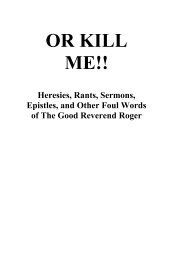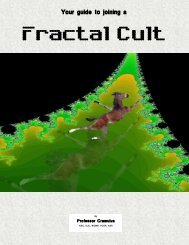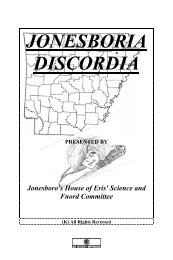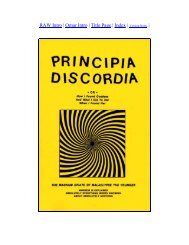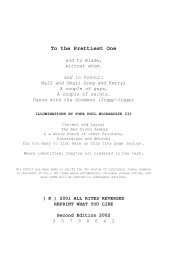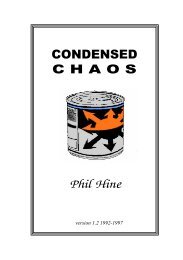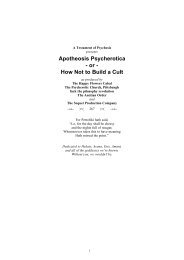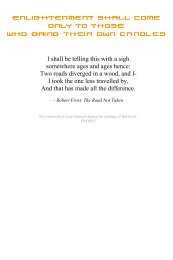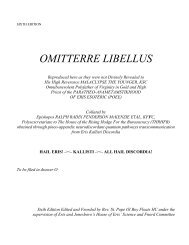Coincidance - Principia Discordia
Coincidance - Principia Discordia
Coincidance - Principia Discordia
You also want an ePaper? Increase the reach of your titles
YUMPU automatically turns print PDFs into web optimized ePapers that Google loves.
COINCIDANCE 95<br />
"as real life." Beneath this surface, as we have already seen, the ghosts of<br />
Homer, Shakespeare, Mozart, and (if I am right about the Good Samaritan<br />
theme) Jesus are present-although-absent as the archetypal themes of their<br />
works are reflected in this everyday bustle of ordinary early 20th Century city.<br />
Everybody in the story is involved in misunderstandings or ambiguities<br />
that become clearer and more hilarious on each re-reading. This existential<br />
fact—that every mind creates its own reality-tunnel—is the abyss of which<br />
Joyce spoke, at nineteen, in the lecture on absence and death from which we<br />
began. Stephen invokes the abyss again in his theory of Hamlet (Chapter 9),<br />
saying fatherhood is like the universe itself in being founded "upon the void,<br />
Upon incertitude." Various Dublin gossips (all male) have different theories<br />
about how many lovers Molly Bloom has had; the reader who believes them<br />
is terribly deceived. In Chapter 17, we are given a list of Molly's lovers which<br />
we are apt to consider definitive; on re-reading, we discover it is not a list of<br />
real lovers but of Bloom's suspicions. Molly's monologue should resolve the<br />
mystery, but only adds to the ambiguity; she is not as promiscuous as gossip<br />
paints her, but the exact number of her infidelities is still uncertain.<br />
By the middle of the book, almost everybody in Dublin thinks Bloom has<br />
won a great deal on the horse race that day. On first reading, we are likely to<br />
think so, too, and wonder why he hasn't gone to pick up his winnings. Only<br />
on careful re-reading do we discover the confusions out of which this<br />
inaccurate rumor got started. A dog who appears vicious and ugly to one<br />
narrator appears "lovely" and almost "human" to another narrator, and a<br />
third narrator claims the dog actually talks. Alf Bergan sees Paddy Dignam<br />
at 4 p.m. but Paddy was buried at 10 in the morning; we are to decide for<br />
ourselves if Alf saw a ghost or just shared in the general fallibility of human<br />
perception. Some Dubliners think Bloom is a dentist, and discovering the<br />
source of that error is amusing to the re-reader. Bloom thinks Molly doesn't<br />
know about his Platonic "affair" with Martha Clifford, but Molly knows<br />
more than he guesses about that and all his other secrets. Nosey Flynn, the<br />
first Dubliner to tell us Bloom is a Freemason, is wrong about everything<br />
else he says; it takes careful study to discover that this font of unreliable<br />
gossip is right about that particular detail.<br />
The tradition of the realistic novel, at this point, has refuted itself, in a<br />
classic Strange Loop. Joyce has given us more realism than any other<br />
novelist and the upshot of it is that we don't know what's real anymore. If<br />
Dante's epic was informed by the philosophy of Aristotle, whom he called<br />
The Master of Those Who Know, Joyce's epic, as Ellman commented, is<br />
dominated by David Hume, the Master of Those Who Don't Know. Is the<br />
man in the brown mackintosh who continually gets entangled with Bloom a<br />
significant figure in Bloom's past (or future?) or is this repeated conjunction



